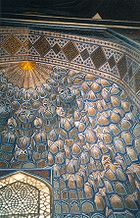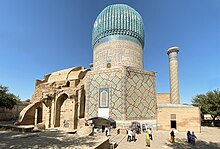| Gur-e Amir | |
|---|---|
 Exterior view of the Gur-e Amir Exterior view of the Gur-e Amir | |
| Religion | |
| Affiliation | Sunni Islam |
| Location | |
| Location | Samarkand, Uzbekistan |
| Country | Uzbekistan |
| Architecture | |
| Type | Mausoleum |
| Style | Islamic |
| Groundbreaking | 1403 |
| Completed | 1404 |
| Specifications | |
| Dome height (outer) | 30 m? |
| Minaret(s) | 2 |
| Minaret height | 30 m? |
The Gūr-i Amīr or Guri Amir (Uzbek: Amir Temur Maqbarasi, Go'ri Amir, Persian: گورِ امیر) is a mausoleum of the Turkic conqueror Timur (also known as Tamerlane) in Samarkand, Uzbekistan. It occupies an important place in the history of Turkestan's architecture as the precursor for and had influence on later Mughal architecture tombs, including Gardens of Babur in Kabul, Humayun's Tomb in Delhi and the Taj Mahal in Agra, built by Timur's Indian descendants, Mongols that followed Indian culture with Central Asian influences. Mughals established the ruling Mughal dynasty of the Indian subcontinent. The mausoleum has been heavily restored over the course of its existence.
Construction

Gur-e Amir means "Tomb of the King" in Persian. This architectural complex with its azure dome contains the tombs of Timur, his sons Shah Rukh and Miran Shah and grandsons Ulugh Beg and Muhammad Sultan. Also honoured with a place in the tomb is Timur's teacher Sayyid Baraka.
The earliest part of the complex was built at the end of the 14th century by the orders of Muhammad Sultan. Now only the foundations of the madrasah and khanaka, the entrance portal and a part of one of four minarets remains.
The construction of the mausoleum itself began in 1403 after the sudden death of Muhammad Sultan, Timur's heir apparent and his beloved grandson, for whom it was intended. Timur had built himself a smaller tomb in Shahrisabz near his Ak-Saray Palace. However, when Timur died in 1405 on campaign on his military expedition to China, the passes to Shahrisabz were snowed in, so he was buried here instead. Ulugh Beg, another grandson of Timur, completed the work. During his reign the mausoleum became the family crypt of the Timurid dynasty.
Architecture

The entrance portal to the Muhammad Sultan ensemble is richly decorated with carved bricks and various mosaics. All the extensions of Ulugh Beg's time are attributed to the architect Muhammad ibn Mahmud from Isfahan.

Outwardly, the Gur-e Amir Mausoleum is a one-cupola building. It is famous for its simplicity of construction and for its solemn monumentality of appearance. It is an octahedral building crowned by an azure fluted dome. The exterior decoration of the walls consists of the blue, light-blue and white tiles organized into geometrical and epigraphic ornaments against a background of terracotta bricks. The dome (diameter – 15 m (49.21 ft), height – 12.5 m (41.01 ft)) is of a bright blue color with deep rosettes and white spots. Heavy ribbed fluting gives an amazing expressiveness to the cupola.
During the reign of Ulugh Beg a doorway was made to provide an entrance into the mausoleum.
Inwardly, the mausoleum appears as a large, high chamber with deep niches at the sides and diverse decoration. The lower part of the walls covered are by onyx slabs composed as one panel. Each of these slabs is decorated with refined paintings. Above the panel there is a marble stalactite cornice. Large expanses of the walls are decorated with painted plaster; the arches and the internal dome are ornamented by high-relief papier-mâché cartouches, gilded and painted.
The ornate carved headstones in the inner room of the mausoleum merely indicate the location of the actual tombs in a crypt directly underneath the main chamber. Under Ulugh Beg's government a solid block of dark green jade was placed over the grave of Tamerlane. Formerly this stone had been used at a place of worship in the Chinese emperor's palace, then as the throne of Duwa (a descendant of Genghis Khan) in Chagatay Khanate. Next to Tamerlane's grave lie the marble tombstones of his sons Miran Shah and Shah Rukh and also of grandsons Muhammad Sultan and Ulugh Beg. Tamerlane's spiritual teacher Mir Said Baraka, also rests here.
History
Erected on the initiative and at the expense of Timur in 1404, this masterpiece of Persian architecture of the Timurid era occupies an important place in the history of world Islamic architecture. The main architect of the mausoleum was Muhammad ibn Mahmud Isfahani, a native of the Iranian city of Isfahan.
Construction

In 1403, after a military campaign against the Ottoman Empire, Muhammad Sultan, Timur's heir to the throne, died. Returning to Samarkand in the fall of 1404, Timur ordered for his grandson the building of a mausoleum, which became the family tomb of Gur-e-Amir. The mausoleum was built in the southeastern part of medieval Samarkand, near the madrasa and khanqah of Muhammad Sultan.
Timur died during a campaign in China. In January 1405, he arrived in the city of Otrar (its ruins - near the confluence of Arys into the Syr Darya), where he fell ill and died (18 February according to most historians, 15 February according to the tombstone of Timur). Timur's body was embalmed, placed in an ebony coffin upholstered in silver brocade, and contrary to the will of Timur, who willed to be buried in his native Kesh, was taken to Samarkand on the initiative of his grandson Khalil-sultan. Tamerlane was buried in the Gur-e-Amir mausoleum, at that time still unfinished. The official mourning events were held on 18 March 1405 by Timur's grandson Khalil-Sultan (1405–1409), who seized the Samarkand throne against the will of his grandfather, who bequeathed the throne to his eldest grandson Pir Muhammed.
During Ulugh Beg's reign, the mausoleum became the Timurid family crypt; a doorway was made to provide an entrance to the mausoleum.
Later enlargement
In this architectural ensemble are the tombs of Timur himself, his sons Shah Rukh (died in 1447 in Herat) and Miran Shah (killed on April 21, 1408 in the vicinity of Tabriz), grandsons - Ulugh Beg (1394–1449) and Muhammad Sultan, also Timurids Abdullo Mirzo, Abdurahmon Mirzo, teacher and mentor of Timur Mir Said Baraka. By the will of Timur's youngest son Shah Rukh, Mir Said Baraka's remains are buried in the Gur-e-Amir Mausoleum. Timur was a Muslim and an admirer of Sufi orders. The main spiritual mentor of Timur was the descendant of the Islamic prophet Muhammad, Sheikh Mir Said Baraka. He was the one who gave Timur the symbols of power: a drum and a banner when he came to power in 1370. Mir Said Baraka predicted a great future for the Emir. He accompanied Timur on his great campaigns. In 1391 he blessed him before his battle with Tokhtamysh. In 1403 they together mourned the unexpected death of the heir to the throne - Muhammad-Sultan. According to the Arab historian Ibn Arabshah Timur constantly said: "All that I have reached in the state and the strongest countries conquered by me - all this was achieved because of the prayer and blessing of Sheikh Shamsuddin al-Khavoriyyah and all the luck found only from Said Baraka". Therefore, Timur himself was also buried at his feet.
Decline and restoration


In 1740, king Nader Shah of the Afsharid Empire tried to carry away Tamerlane's sarcophagus. Nader idolized Timur. He imitated Timur's military prowess and, later in his reign, Timur's cruelty, but in the process of removal the sarcophagus broke in two. This was interpreted as a bad omen. His advisers urged him to return the stone to its rightful place.
Unfortunately, after the end of 17th century Samarkand suffered a long period of decline. The city lost the status of capital to Bukhara. The great Silk Road bypassed the city and its great historical monuments stood empty and forgotten. Only after the Second World War did extensive restoration work in Gur-Emir begin.
Tamerlane's tomb was opened shortly before the German invasion of the Soviet Union on 19 June 1941. The exhumation of Timur in 1941 was made under the direction of Soviet scientist and anthropologist Mikhail Mikhaylovich Gerasimov, who was able to reconstruct Timur's facial features from his skull, and it was also confirmed that he was 172 cm in height and would have walked with a pronounced limp.
In the 1950s the dome, main portal and minarets were refurbished. By that time the maiolica tiles had mostly fallen away. In the 1970s, the restoration of the interior was undertaken. Neither the Madrasah nor the Khanaka of initial Muhammad Sultan's complex were reconstructed at that time. With the resurgence of the interest in Tamerlane after the founding of the Republic of Uzbekistan in 1991, care of his places of worship has intensified.
Curse of Timur
Main article: Curse of TimurWhen Soviet scientists wanted to open Timur's tomb, rumors went around Samarkand that opening the tomb would curse those who opened it. Local leaders attempted to warn the excavation team of the "risks".
The tomb is inscribed with two warnings that read "When I rise from the dead, the world shall tremble". Allegedly, once opened another inscription was discovered: “Whosoever disturbs my tomb will unleash an invader more terrible than I". Even though people close to Gerasimov claim that this story is a fabrication, the legend persists.
The tomb was opened by Mikhail Mikhaylovich Gerasimov, a Soviet archaeologist on 20 June 1941, two days before the Nazis invaded the Soviet Union.
Apparently, Stalin believed in the curse and ordered Timur be reburied. Tamerlane was reburied with full Islamic burial rites on 20 December 1942, about one month before the Soviet victory at Stalingrad (though by this time the German Army at Stalingrad was already encircled).
Nearby monuments
Some consider the Gur-e Amir, Ruhabad mausoleum and Aksaray mausoleum to be a combined ensemble because of their closeness.
Ruhabad (14th century) is a small mausoleum and is said to contain a hair of Muhammad. The one-story madrasah now accommodates craftsmens' shops. There is a functioning mosque next door to the madrasah. All three combine into one ensemble.
The Aksaray mausoleum (15th century), recently restored, is located on a quiet street behind Gur-e Amir.
See also
References
- Marozzi, Justin. Tamerlane: sword of Islam, conqueror of the world. London, Harper Collins, 2004
- "Gur-e Amir Mausoleum". Uzbekistan: Remarkable sights of Samarkand. Central Asia Travel. Retrieved 26 August 2020.
- Berndl, Klaus (2005). National Geographic Visual History of the World. National Geographic Society. pp. 318–320. ISBN 978-0792236955.
- Foltz, Richard (July 1996). "The Central Asian Naoshbandī Connections of the Mughal Emperors". Journal of Islamic Studies. 7 (2): 229–239. doi:10.1093/jis/7.2.229. Retrieved 26 August 2020.
- کريم, پيرنپا، محمد (8 May 2021). سبک شناسى معمارى ايرانى - پيرنپا، محمد کريم - Google Books. Surūš-i Dāniš. ISBN 9789649611327. Archived from the original on 8 May 2021. Retrieved 6 November 2023.
- Б. Н. Засыпкин. Архитектура Средней Азии древних и средних веков. — М.: Академия архитектуры СССР, 1948. — С. 99. — 160 с.
- Дж. Мароцци. «Тамерлан: Завоеватель Мира» — Москва: «АСТ», 2009
- Ибн Арабшах, 2007, с. 27.
- ^ Dmitriy Page. "Gur-Emir Mausoleum". Retrieved 6 October 2015.
- ^ "The Curse of Tamerlan: legend or fact?". www.advantour.com. Retrieved 24 July 2020.
- ^ "How The Curse of Timur's Tomb changed the course of World War II". DocumentaryTube. 7 July 2015. Retrieved 24 July 2020.
- "Facial Reconstruction, Nazis, and Siberia: The story of Mikhail Gerasimov". 25 January 2011. Retrieved 9 November 2020.
Sources
External links
Photo gallery
39°38′54″N 66°58′08″E / 39.64833°N 66.96889°E / 39.64833; 66.96889
| Iranian architecture | ||||||
|---|---|---|---|---|---|---|
| Periods |
|  | ||||
| Types | ||||||
| Elements | ||||||
| Traditional cities | ||||||
| Theory and analysis | ||||||
| Lists | ||||||







